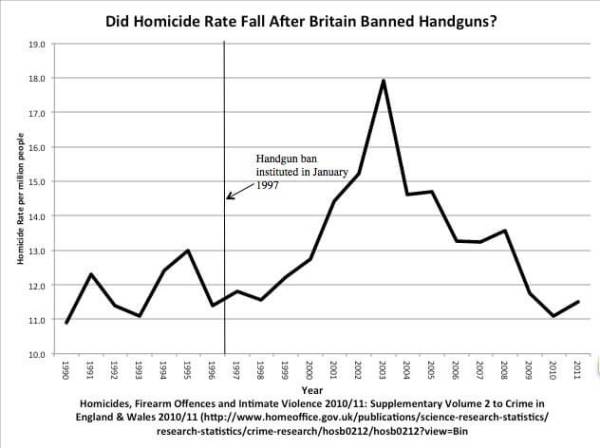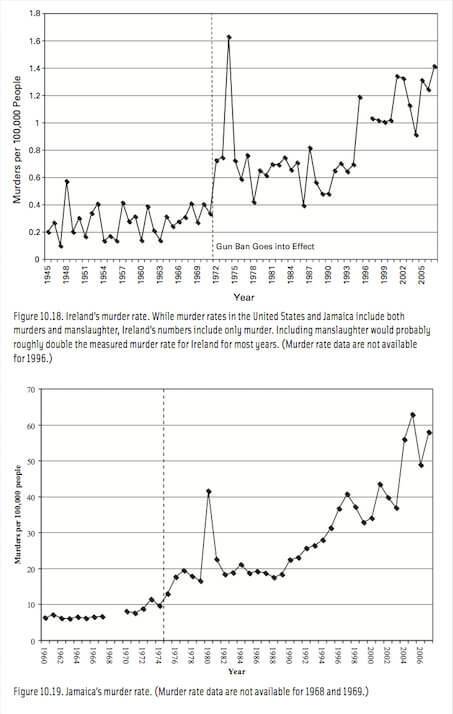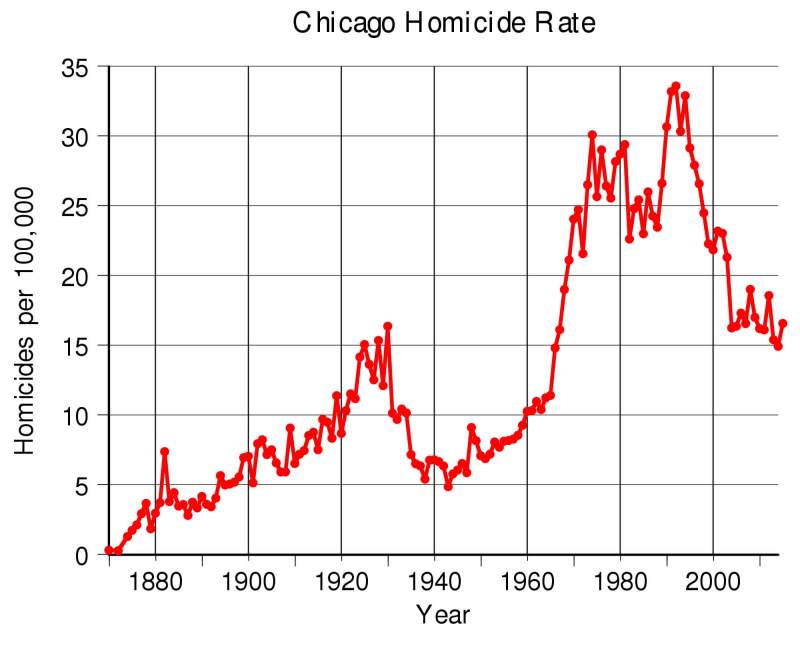Saturday, June 02, 2018 3:24:39 PM
Murder Rates Rise When Guns Are Banned
MASSIVE GUN STUDY CONCLUDES: ‘Murder Rates Rise When Guns Are Banned’
May 12, 2018 By Erik Walters
Do They Want To Save Lives Or Be Right?
Liberals forget that we all want the same thing in the gun-rights debate, we all want to save lives. The question is how to best accomplish that goal.
With Bloomberg and his cronies pour millions into the movement to take away our guns it is no wonder that many Americans believe the only way to accomplish this goal is to take away the guns from law abiding citizens.
“Just The Facts, Ma’am”
Gun-control advocates somehow believe that making guns illegal will be more effective than making heroin illegal, that bad guys will suddenly turn in their guns and there will be peace in the land.
They believe all sorts of things that just aren’t true and forget that defending ourselves from criminals has nothing to do with our Second Amendment. They also ignore some other critical FACTS that make their position entirely untenable.
If they really want peace in the land they might want to look at the data that says otherwise, and check out the Crime Prevention Resource Center that has the numbers to prove it.
In an excellent article at westernjournal.com explains:
The 2013 study looked at murder rates from places that had banned guns around the world, from Washington, D.C. and Chicago to England, Wales, Jamaica and even the Solomon Islands, an archipelago in the South Pacific which only had mass shootings after they decided to ban guns.
The most striking example might be that of England and Wales, both of which banned firearms back in 1997. Homicides rose from 676 to 734 the first year of the ban. And things only got worse from there.
“After the ban, clearly homicide rates bounce around over time, but there is only one year (2010) where the homicide rate is lower than it was in 1996,” the CPRC noted. “The immediate effect was about a 50 percent increase in homicide rates. Firearm homicide rate had almost doubled between 1996 and 2002 … The homicide and firearm homicide rates only began falling when there was a large increase in the number of police officers during 2003 and 2004. Despite the huge increase in the number of police, the murder rate still remained slightly higher than the immediate pre-ban rate.”

(Data charts from the CPRC)
The highest recorded murder rate was in 2002/03, which saw 1,041 murders. That number included 172 murders by Dr. Harold Shipman, a notorious physician and serial killer who murdered his patients via lethal doses of morphine. That said, the general trend was still toward more killings after the gun ban was put into place.
Meanwhile, Jamaica’s murder rate was at roughly 10 killings per 100,000 people in 1974, when guns were banned. By 1980, that number spiked to over 40 per 100,000, and 58 per 100,000 in 2005. While the numbers have again bounced around, Jamaica didn’t see under 20 murders per 100,000 people between 1990 and 2007. According to the Jamaica Gleaner, 38 people were murdered in the first six days of this year alone.
Ireland also saw a spike when it banned guns, the CPRC reports, from under 0.4 murders per 100,000 in 1972 to over 1.6 per 100,000 in just a few years, an increase of well over 400 percent. While that was the peak of the murder rate, it never fell below what it was the year before the gun ban.

(Data charts from the CPRC)
Chicago also banned guns in 1982. How did that work? Well, the Windy City has always had a high homicide rate, but as you can see, it rose dramatically in the years following the ban. While there was a reduction in the 2000s, it rebounded again in the 2010s to become the gunshot capital of America.

Washington, D.C., meanwhile, banned handguns in 1976. That year, there were 188 murders in the nation’s capital. In the first decade of the ban, only three years saw lower murder totals. Then, in 1988, murder began to explode in the city, with 369 murders. The next year, it was 434. D.C. wouldn’t see a year with fewer murders than that until 1994, when the city recorded 399 murders.
In 2007, Heller v. D.C. struck down the ban on guns in D.C. That year, there were 181 murders. In the years since, only one year — 2008 — exceeded that total.
Perhaps the most striking thing is that three of the case studies here — England and Wales, Jamaica and Ireland — are on islands. That means you don’t exactly have guns coming over a land border. So, why did murder not only persist but rise after these gun bans?
Maybe it’s because criminals found other ways to get guns. Maybe it’s because there were less armed citizens to protect themselves. Maybe it’s because criminals will always find ways to kill other people if they want to kill them. And maybe it’s all of these.
No matter what the reason, the conclusion from the data is clear: gun bans don’t stop murder. Far from it. This is the kind of data gun rights advocates need to know for themselves. And these are by no means the only examples — as the CPRC noted.
The next time you hear a gun-control advocate expressing their heart-felt position you might explain that you know how they feel and suggest that, if they really want to save lives, they might want to look at the facts.
http://libertyparkpress.com/sorry-liberals-massive-gun-study-concludes-murder-rates-rise-when-guns-are-banned/
Note: There are active links contained within the original article at the website posted above.
MASSIVE GUN STUDY CONCLUDES: ‘Murder Rates Rise When Guns Are Banned’
May 12, 2018 By Erik Walters
Do They Want To Save Lives Or Be Right?
Liberals forget that we all want the same thing in the gun-rights debate, we all want to save lives. The question is how to best accomplish that goal.
With Bloomberg and his cronies pour millions into the movement to take away our guns it is no wonder that many Americans believe the only way to accomplish this goal is to take away the guns from law abiding citizens.
“Just The Facts, Ma’am”
Gun-control advocates somehow believe that making guns illegal will be more effective than making heroin illegal, that bad guys will suddenly turn in their guns and there will be peace in the land.
They believe all sorts of things that just aren’t true and forget that defending ourselves from criminals has nothing to do with our Second Amendment. They also ignore some other critical FACTS that make their position entirely untenable.
If they really want peace in the land they might want to look at the data that says otherwise, and check out the Crime Prevention Resource Center that has the numbers to prove it.
In an excellent article at westernjournal.com explains:
The 2013 study looked at murder rates from places that had banned guns around the world, from Washington, D.C. and Chicago to England, Wales, Jamaica and even the Solomon Islands, an archipelago in the South Pacific which only had mass shootings after they decided to ban guns.
The most striking example might be that of England and Wales, both of which banned firearms back in 1997. Homicides rose from 676 to 734 the first year of the ban. And things only got worse from there.
“After the ban, clearly homicide rates bounce around over time, but there is only one year (2010) where the homicide rate is lower than it was in 1996,” the CPRC noted. “The immediate effect was about a 50 percent increase in homicide rates. Firearm homicide rate had almost doubled between 1996 and 2002 … The homicide and firearm homicide rates only began falling when there was a large increase in the number of police officers during 2003 and 2004. Despite the huge increase in the number of police, the murder rate still remained slightly higher than the immediate pre-ban rate.”

(Data charts from the CPRC)
The highest recorded murder rate was in 2002/03, which saw 1,041 murders. That number included 172 murders by Dr. Harold Shipman, a notorious physician and serial killer who murdered his patients via lethal doses of morphine. That said, the general trend was still toward more killings after the gun ban was put into place.
Meanwhile, Jamaica’s murder rate was at roughly 10 killings per 100,000 people in 1974, when guns were banned. By 1980, that number spiked to over 40 per 100,000, and 58 per 100,000 in 2005. While the numbers have again bounced around, Jamaica didn’t see under 20 murders per 100,000 people between 1990 and 2007. According to the Jamaica Gleaner, 38 people were murdered in the first six days of this year alone.
Ireland also saw a spike when it banned guns, the CPRC reports, from under 0.4 murders per 100,000 in 1972 to over 1.6 per 100,000 in just a few years, an increase of well over 400 percent. While that was the peak of the murder rate, it never fell below what it was the year before the gun ban.

(Data charts from the CPRC)
Chicago also banned guns in 1982. How did that work? Well, the Windy City has always had a high homicide rate, but as you can see, it rose dramatically in the years following the ban. While there was a reduction in the 2000s, it rebounded again in the 2010s to become the gunshot capital of America.

Washington, D.C., meanwhile, banned handguns in 1976. That year, there were 188 murders in the nation’s capital. In the first decade of the ban, only three years saw lower murder totals. Then, in 1988, murder began to explode in the city, with 369 murders. The next year, it was 434. D.C. wouldn’t see a year with fewer murders than that until 1994, when the city recorded 399 murders.
In 2007, Heller v. D.C. struck down the ban on guns in D.C. That year, there were 181 murders. In the years since, only one year — 2008 — exceeded that total.
Perhaps the most striking thing is that three of the case studies here — England and Wales, Jamaica and Ireland — are on islands. That means you don’t exactly have guns coming over a land border. So, why did murder not only persist but rise after these gun bans?
Maybe it’s because criminals found other ways to get guns. Maybe it’s because there were less armed citizens to protect themselves. Maybe it’s because criminals will always find ways to kill other people if they want to kill them. And maybe it’s all of these.
No matter what the reason, the conclusion from the data is clear: gun bans don’t stop murder. Far from it. This is the kind of data gun rights advocates need to know for themselves. And these are by no means the only examples — as the CPRC noted.
The next time you hear a gun-control advocate expressing their heart-felt position you might explain that you know how they feel and suggest that, if they really want to save lives, they might want to look at the facts.
http://libertyparkpress.com/sorry-liberals-massive-gun-study-concludes-murder-rates-rise-when-guns-are-banned/
Note: There are active links contained within the original article at the website posted above.
Join the InvestorsHub Community
Register for free to join our community of investors and share your ideas. You will also get access to streaming quotes, interactive charts, trades, portfolio, live options flow and more tools.







